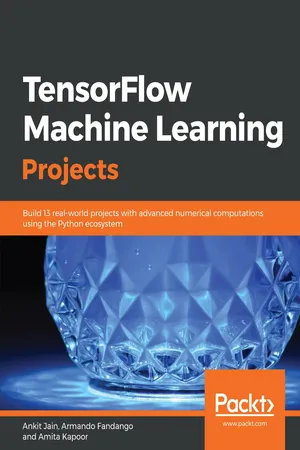
TensorFlow Machine Learning Projects
Build 13 real-world projects with advanced numerical computations using the Python ecosystem
Ankit Jain, Armando Fandango, Amita Kapoor
- 322 Seiten
- English
- ePUB (handyfreundlich)
- Über iOS und Android verfügbar
TensorFlow Machine Learning Projects
Build 13 real-world projects with advanced numerical computations using the Python ecosystem
Ankit Jain, Armando Fandango, Amita Kapoor
Über dieses Buch
Implement TensorFlow's offerings such as TensorBoard, TensorFlow.js, TensorFlow Probability, and TensorFlow Lite to build smart automation projects
Key Features
- Use machine learning and deep learning principles to build real-world projects
- Get to grips with TensorFlow's impressive range of module offerings
- Implement projects on GANs, reinforcement learning, and capsule network
Book Description
TensorFlow has transformed the way machine learning is perceived. TensorFlow Machine Learning Projects teaches you how to exploit the benefits—simplicity, efficiency, and flexibility—of using TensorFlow in various real-world projects. With the help of this book, you'll not only learn how to build advanced projects using different datasets but also be able to tackle common challenges using a range of libraries from the TensorFlow ecosystem.
To start with, you'll get to grips with using TensorFlow for machine learning projects; you'll explore a wide range of projects using TensorForest and TensorBoard for detecting exoplanets, TensorFlow.js for sentiment analysis, and TensorFlow Lite for digit classification.
As you make your way through the book, you'll build projects in various real-world domains, incorporating natural language processing (NLP), the Gaussian process, autoencoders, recommender systems, and Bayesian neural networks, along with trending areas such as Generative Adversarial Networks (GANs), capsule networks, and reinforcement learning. You'll learn how to use the TensorFlow on Spark API and GPU-accelerated computing with TensorFlow to detect objects, followed by how to train and develop a recurrent neural network (RNN) model to generate book scripts.
By the end of this book, you'll have gained the required expertise to build full-fledged machine learning projects at work.
What you will learn
- Understand the TensorFlow ecosystem using various datasets and techniques
- Create recommendation systems for quality product recommendations
- Build projects using CNNs, NLP, and Bayesian neural networks
- Play Pac-Man using deep reinforcement learning
- Deploy scalable TensorFlow-based machine learning systems
- Generate your own book script using RNNs
Who this book is for
TensorFlow Machine Learning Projects is for you if you are a data analyst, data scientist, machine learning professional, or deep learning enthusiast with basic knowledge of TensorFlow. This book is also for you if you want to build end-to-end projects in the machine learning domain using supervised, unsupervised, and reinforcement learning techniques
Häufig gestellte Fragen
Information
Classifying Clothing Images using Capsule Networks
- Understanding the importance of capsule networks
- A brief understanding of capsules
- The routing by agreement algorithm
- The implementation of the CapsNet architecture for classifying Fashion-MNIST images
- The limitations of capsule networks
Understanding the importance of capsule networks
Inhaltsverzeichnis
- Title Page
- Copyright and Credits
- Dedication
- About Packt
- Contributors
- Preface
- Overview of TensorFlow and Machine Learning
- Using Machine Learning to Detect Exoplanets in Outer Space
- Sentiment Analysis in Your Browser Using TensorFlow.js
- Digit Classification Using TensorFlow Lite
- Speech to Text and Topic Extraction Using NLP
- Predicting Stock Prices using Gaussian Process Regression
- Credit Card Fraud Detection using Autoencoders
- Generating Uncertainty in Traffic Signs Classifier Using Bayesian Neural Networks
- Generating Matching Shoe Bags from Shoe Images Using DiscoGANs
- Classifying Clothing Images using Capsule Networks
- Making Quality Product Recommendations Using TensorFlow
- Object Detection at a Large Scale with TensorFlow
- Generating Book Scripts Using LSTMs
- Playing Pacman Using Deep Reinforcement Learning
- What is Next?
- Other Books You May Enjoy